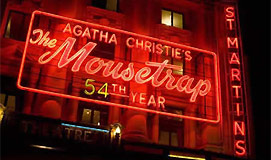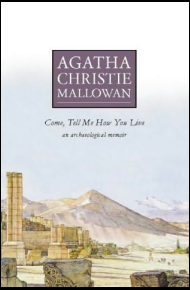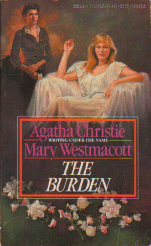Other Genres of Agatha's
Agatha Christie wrote more than just detective fiction. She has published six romance novels, two collections of poetry, one children's book, two autobiographies, and was also a playwright.

St. Martin's Theatre at the West End, London. This is home to the play The Mousetrap since 1974.
In fact, her play The Mousetrap is the longest-running show in the world. Its premiere dates back to 1952, which was a short story before then. Currently it plays at the St. Martin's Theatre at the West End, London (transferred there in 1974). Another play adapted from short story form is Witness for the Prosecution, although not as popular as the aforementioned Mousetrap. These two productions can still be seen around the world, from London to local high schools in the United States. It would be remiss not forget mentioning the play Ten Little Indians (or And Then There Were None), based on the world's best-selling mystery ever. It first appeared on stage in 1943 and still is a great production everywhere today.
Much can be learned about Agatha Christie the person and author from her "other works or genres". We don't get much about her personal life and feelings from detective novels or plays, but rather from her more intimate work. Take, for instance, her poetry, autobiographies, and romance novels. Then Agatha Christie starts to take shape.
Christie's An Autobiography details both her personal and professional life up till 1965. It received great praise from the critics when published in 1977. Comments said regarding this (her longest book) were such as: "a book with much leisurely charm" (Atlantic Monthly), "there is a lack of depth about the work" (Times Literary Supplement), and "the book's prevailing tone is of a child-like gaiety and enjoyment of life" (the Economist).

HarperCollins' edition of Come, Tell Me How You Live, published in 1999.
Her other "autobiography" is the account of her travels in the Middle East with her husband archaeologist Max Mallowan. The perfectly titled Come, Tell Me How You Live retells her associations with the kind people there and of the archaeological work (which she performed along with her husband's team). Comments made on this book included: "such an entertaining book" (NY Herald Tribune) and "the lightest and gayest account imaginable . . . we have laughed our way to an understanding of the East" (Christian Science Monitor).
Not many might think of Christie as a poet. She had written poetry probably dating back to her teenage years and World War I. The first collection of poems, published in 1924, is meaningful to Christie fans because she writes poetry of Harlequin and other characters from the Italian Commedia dell'Arte. Her poetry is, of course, a precursor to her hero Mr. Harley Quin. Christie once said her favorite character of those that she created was Harley Quin. The Harlequin has always fascinated her since her childhood when her Auntie-Grannie owned porcelain figurines of the Commedia dell'Arte. The second collection published in 1973 contains two sections, the first being the poems from 1924. The second section is of 27 compositions focusing on places Christie had visited, nostalgia for lost childhood, and art and beauty.

Published in 1956, The Burden was the last of the romance novels by Christie. Dell, 1983.
Agatha Christie published six romance novels under the pen name of Mary Westmacott, the first in 1930 and the sixth one in 1956. Why did she? She once stated that writing detective stories became for her "a proper job". Christie was an introverted and shy woman who didn't publicly reveal her emotions. What if she wanted to express herself? She once said, "Writing is a great comfort to people like me, who are unsure of themselves and have trouble expressing themselves properly." She couldn't just do this in a detective novel, of course. What better medium to express yourself than in a romance novel? Christie reported that she was "with a rather guilty feeling" doing this. The first two of these romance novels were very autobiographical and, I imagine, therapeutic for her (considering the themese of the books coinciding with Christie's personal life).
Would these "other works" be of any value? We get the most personal glimpses of Agatha Christie the person and author through the autobiographies, poetry, and the Westmacott novels. These then demand careful consideration and examination for the serious Christie fan and reader.